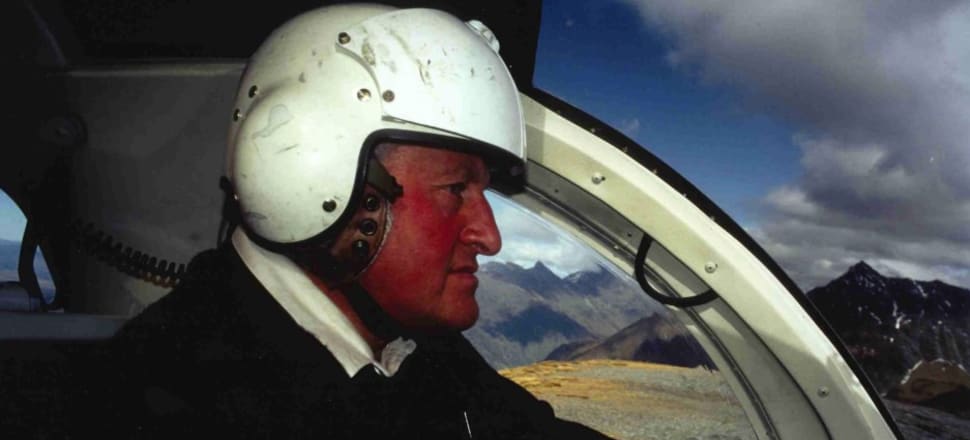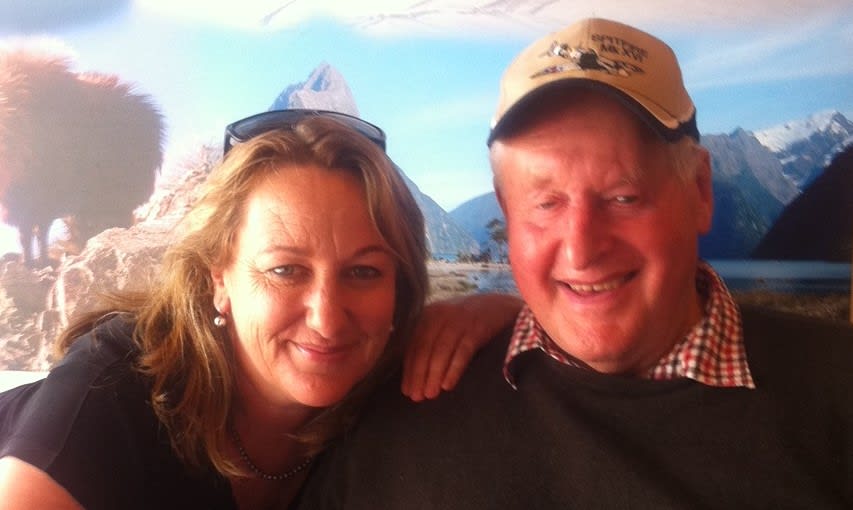
Sir Tim Wallis had an outsized impact on the lives of those around him. The deer industry pioneer and renowned collector of WWII fighter aircraft always thought big and inspired others to do the same.
Newsroom’s Investigations editor Melanie Reid and I first met Sir Tim Wallis in 1992. We were based in Christchurch working for TV3’s 60 minutes programme and thought Sir Tim would make a great story. He was plain old Tim back then, but he was well known, particularly in the South Island. He was a pioneer of helicopter deer recovery, successful businessman, founder of Warbirds over Wānaka, spitfire pilot and notoriously media shy.
Melanie had been sending him a fax every month for 11 months before she received a reply.
As a kid growing up in Queenstown, she was fascinated by the deer shooting and recovery operations of helicopter pilots like Tim Wallis.
“They would sometimes land the helicopters at Arthur’s Point pub, and I would ride past on my pony and see them all having a beer, covered in blood…choppers not cars in the pub car park."

We finally got a reply from Tim suggesting he would need to meet us in person before he would consider an interview. Later, we would understand that Tim liked to get the measure of people before doing business with them.
Melanie and I jumped on an early morning commercial flight to Queenstown and drove over to Wānaka airport where Tim had an office in the hangar that housed his growing collection of aircraft – some modern, some warbirds.
The welcome from his longtime assistant, Nola, wasn’t, shall we say, overly warm. Tim was away “somewhere” and was expected back “sometime”. We waited out the front of the hangar that faced the runway. Hours passed before a helicopter flew in. Out hopped its pilot and only occupant Tim Wallis. We introduced ourselves but Tim walked straight past us saying he didn’t have time to talk to us.
The brush off left us panicked and unsure what to do. We hung around and finally Ray Mulqueen, Tim’s chief aircraft engineer and right-hand man, wandered over to us. “Don’t worry, he can be a bit like that. Just stay put and I'll see what I can do.”
Eventually, we were invited in. Wallis was gruff, almost scary. He decided he would give us an interview but there would be rules. He wasn’t keen on discussing his brush with Civil Aviation for low flying in his spitfire.
The interview happened a few weeks later. Melanie who was on one of her first current affairs reporting assignments was more nervous than I've ever seen her, and we have worked together for 34 years and been in many hair-raising situations.
“Back then I was truly shaking in my shoes – he was such a legend and such a hero, and I was just some kid journalist who had begged him to do a story.”
The interview was going well until Melanie asked Wallis about the Civil Aviation charges he was on for doing a barrel roll over the Burwood spinal unit in his spitfire. Patients had been wheeled outside in the beds to watch, and Tim put on a show.
His response to the question he was hoping we wouldn’t ask was to say “what” and glare at Mel. But he answered, saying he had done it to boost the morale of the patients. He had been one himself for months as he recovered from breaking his back in a helicopter accident.
He had promised the hospital staff and patients that he would do a fly past and Tim always kept his word.
After our interview with him, we asked Tim if we could put cameras inside his spitfire and film him flying it. We also asked, outrageously, if we could be dropped on the top of a mountain and have him do a high-speed diving run past us while Melanie did a piece to camera. He agreed, partly I think because he saw it as a flying challenge.
We were dropped by helicopter on to the top of a steep peak and called up Tim in the spitfire on a 2-way radio he had given us. The weather was perfect, and Tim dived past at 400 mph framed by mountains and the lake. Mel got her lines perfectly. It was done – we could hardly believe it.
The 60 Minutes story covered Tim’s role in the deer industry. He told us about how his team had shot 35,000 deer in one year. Tim had flown many of the carcasses out from the back country himself.
“Once you’re out there in the hills, you’ve got no one watching you and you are your own judge.
“I can remember logging 50 hours in under five days, that’s pretty pressurised flying.”
“There wasn’t any limitation other than weather and daylight. You’d basically start at daylight and end at dusk, and whatever you had you had to bring out and sometimes you had to stretch that out a little.”
Between 9000 and 10,000 live deer captured back to farms, all had to be captured individually. “When you look back on it, it was really quite a feat.”
In the 1980s 50 percent of all deer farmed in this country were from Wallis’ stock. Tim’s own farming interests expanded to Canada, US and, eventually Russia. Deer had made Tim Wallis a lot of money.

After the 60 Minutes story went to air, Tim sent us a letter saying how much he enjoyed it.
He told us the judge in his low flying case had also seen it, referring to it in his judgment saying he didn’t feel inclined to find him guilty after seeing what sort of person Wallis was and discharged him without conviction.
It wasn’t long before Tim was on the phone to Melanie suggesting that we go with him to Russia. He had bought an old aircraft factory in Siberia that had made fighters for Russia before and during World War 2. He had hired back the original craftsmen who were still alive and began restoring crashed Polikarpovs.
The first of these aircraft would soon fly and Tim thought we should film it and make a documentary.
Looking back, Melanie and I now see how privileged we were to make this documentary.
“It was just so exciting to be flying all round the world with Tim. We went from airshows to boardrooms to dusty, long forgotten Siberian airfields where vodka sessions would take place in secret hangers.”
We also ran into the Russian mafia. Tim was looking to buy the wreck of a Messerschmitt 109 and restore it. These planes were being retrieved from the frozen tundra of northern Russia, but the mafia controlled the trade. We travelled to St Petersburg where one was stored at the Russian airbase. Tim wasn’t comfortable with who he was dealing with and decided not to buy.
On the long flights, car journeys and late meals we would talk to Tim about his business philosophy and his approach to problems.
“Pick more winners than losers” he would tell us. “Never be afraid to admit you're wrong and do a 360 if you have to.”
We came to deeply admire him. His physical stamina was amazing. His helicopter accident meant he carried a heavy metal brace on one leg and limped badly. He must have been in pain a lot of the time, but we never heard him complain. And, of course, none of this mattered when he was flying a helicopter or a spitfire. “I was a born aviator,” he once told us in an interview. Not immodestly, just a fact.
If we suggested to him that making a documentary was stressful, he liked to quote WWII allied fighter pilots at us “If you think that is stress try being a rookie pilot with a Messerschmitt on your tail.” Fair enough.
To Tim those young fighter pilots were absolute heroes. Many were elderly men when he later met them and there was nothing, he wouldn’t do for them. He truly loved their company and they his.

In 1995 he asked Melanie if she would film a special event he was putting on.
“It was the 50th anniversary of VE Day and the government refused to pay for any commemorations. Tim wasn’t happy about that so he organised a massive air show at the Wigram airbase in Christchurch. He put on a bus from every RSA in the South Island and all the old pilots and soldiers turned up – I remember about 1 pm in the afternoon one of Tim’s sons told me that $80,000 had been spent on the bar already. Tim paid. It was his way of thanking those men for what they had done for New Zealand. He was one of the most generous, kind people I have ever met.”
Tim Wallis was appointed a Knight Bachelor in the 1994 New Year Honours, for services to deer farming, export and the community. But unknown to most people he initially turned the honour down. He found the idea of being called Sir, embarrassing. He was talked into accepting it by his friends and family.
When Melanie asked him in an interview if his knighthood changed anything he replied; “It hasn’t affected the family at all, we’re still the same. I didn’t go up a grade in cars or anything, I’ve kept my old Holden.”
In Jan 1996 Tim crashed his Spitfire on take-off from Wānaka. He was given a 10 percent chance of recovering from his coma. Just like those young fighter pilots he admired so much he beat the odds.
A few weeks ago, Melanie went to visit Tim and his wife Lady Prue in Wānaka. Tim greeted her with his usual big smile, and they discussed Russia and the documentary. It was her chance to say goodbye.
“He had a huge influence on my life. If ever things get tough, I think of him. He influenced a lot of people’s lives - whether he knew this or not, I’m not really sure.
“For those of us lucky enough to have spent time with him, we will have lasting memories of great times, wild times, mad times - some unbelievable – but whatever the adventure you were on with him, it was always one hell of an experience. Unforgettable, just like Tim himself.”







